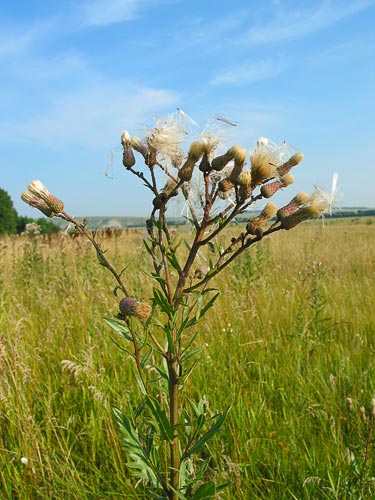Weeds
Cirsium setosum (Willd.) Bess. - Bristly Thistle.
Taxonomic position.
Family Asteraceae (Compositae), genus Cirsium Hill, subgenus Breea (Less.) Tzvel.Synonyms.
Serratula setosa Willd., Cirsium setosum (Willd.) Bess., C. setosum (Willd.) Bieb., Cirsium arvense (L.) Scop. var. setosum (Willd.) Iljin., Vreea setosa (Willd.) Sojak.Biological group.
Summer-green perennial plant that forms offshoots.Morphology and biology.
Root system is well developed. It consists of a main stalky root (2-3 m) and numerous horizontal lateral rhizomes, which generate new stalks. Stalk is 50-150 cm in height, upright, ramified, striated or costate, wingless, glabrous or slightly cobwebby pubescent. Phyllotaxy alternate. Leaves are green, sedentary or short-petiolate, oblong or lanceolate, integral or slightly pinnati-lobate, glabrous or cobwebby pubescent from below, 5-15 (20) cm in length and 1-5 cm in width, with dense fine marginal thorns. It is a dioecious plant. Female pistillate flowers are situated in some calathidia, and male staminate flowers in others. Flowers are unisexual owing to insufficient development of either pistils or stamens. Color of flowers is lilac, pink, or purple. Limbus of corolla is pentamerous, with lobes separated from base. The limbus is several times shorter than tube of corolla, viz 2 times shorter in staminate flowers and 4-5 times shorter in pistillate flowers. Anthers at the base have apically jagged appendages; staminal filaments are glabrous. Floral calathidia are small (1-2 cm in diameter), always upright on cobwebby stalks, gathering in corymbose-paniculate inflorescence. Receptacle flat with long bracts. Involucre of staminate calathidia is 1 cm in diameter; the same for involucre of pistillate spherical calathidia. Leaflets of involucre pluriserial, imbricate, rough from outside; cobwebby pubescent, often violet along margins. External leaflets are oblong-ovate, accumbent, thorn-like acuminate; internal ones are lanceolate, thornless. Fruit is an oblong olive-yellowish or brownish hemicarp with indistinct longitudinal grooves. Length of hemicarp is 2.5-4 mm; its thickness is about 1 mm, weight is 2 mg. Pappus is dirty-white, during flowering shorter than nimbus; by the end of flowering it extends almost 3 times longer than nimbus during fruiting. Reproduction occurs by seeds and cloning (root offsprings). The plant grows from April until October, blossoms from May until July. Seeds ripen in September-October.Distribution.
Cirsium setosum is distributed in all Eurasia; introduced into North America. Described as originating in Europe (Poland). The species is distributed in the entire former USSR, i.e., in the European part, Caucasus, south of Siberia, north of Central Asia (Aral-Caspian floristic area).Ecology.
The species prefers damp meadows. It grows on rich, neutral, and slightly acidic soils. It is widely distributed in forests and steppes, especially in southern taiga and forest-steppe. In nature the Thistle grows along river banks, meadows and in steppes, in inundated forests. In anthropogenic landscapes it frequently grows among crops, fallow lands, meadows, pastures, and refuse sites.Economic significance.
Litters crops in the entire territory of the former USSR, i.e., in the European part (southern taiga, eastern part of broad-leaved forest belt, steppe and forest-steppe), in the Caucasus (Ciscaucasia and Northern Caucasus), in Western Siberia (taiga, forest-steppe, and steppe), in Eastern Siberia (taiga and steppe), in the Far East (Primorskii Territory), and in Central Asia. It occurs in all crops but is more abundant in winter grain crops and perennial grasses. Its weediness is especially great in southern taiga and forest-steppe. Control measures: Soil treatment directed at cutting into the finest parts and digging them deep into ground is the most effective measure against C. setosum before fructification. Crop rotation (fallow - winter-crop - row-crop or perennial grasses) may be recommended as the main control measure.Reference citations.
Cherepanov, S.K. 1995. Vascular plants of Russia and adjacent states (of the former USSR). Saint-Petersburg: Mir i semja-95. 991 pp. (in Russian).Keller, B.A., Lyubimenko, V.N., Maltsev, A.I., Fedchenko, B.A., Shishkin, B.K., Rodzevich, R.Yu. & Kamenskii, K.V., eds. 1934. Weed plants of the USSR. Moscow & Leningrad: AS USSR. V.3. 448 pp. (in Russian).
Krasnoborov, I.M., ed. 1997. Flora of Siberia. Novosibirsk: Nauka. V.13. 472 pp. (in Russian)..
Maltsev, A.I. 1937. Atlas of the major species of weed plants of the USSR. Moscow - Leningrad: Selkhosgiz. V.1. 168 pp. (in Russian)..
Maltsev, A.I. 1937. Atlas of the major species of weed plants of the USSR. Moscow & Leningrad: Selkhosgiz. V.1. 168 pp. (in Russian)..
Nikitin, V.V. 1983. Weed plants of the USSR flora. Leningrad: Nauka. 454 pp. (in Russian)..
Ramenskii, L.G., Tsatsenkin, I.A., Chizhikov, O.N. & Antipin, N.A. 1956. Ecological evaluation of the fodder lands by vegetation cover. Moscow. 472 pp. (in Russian)..
Tsvelev, N.N. 2000. Keys to the vascular plants of North-West Russia (Leningrad, Pskov and Novgorod Regions). Saint-Petersburg. 781 pp. (in Russian)..


